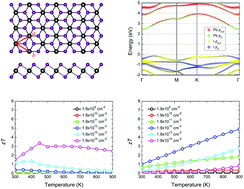High thermoelectric efficiency in monolayer PbI2 from 300 K to 900 K†
Abstract
By using a first-principles approach, monolayer PbI2 is found to have great potential in thermoelectric applications. The linear Boltzmann transport equation is applied to obtain the perturbation to the electron distribution by different scattering mechanisms. The mobility is mainly limited by the deformation-potential interaction with long-wavelength acoustic vibrations at low carrier concentrations. At high concentrations, ionized impurity scattering becomes stronger. The electrical conductivity and Seebeck coefficient are calculated accurately over various ranges of temperature and carrier concentration. The lattice thermal conductivity of PbI2, 0.065 W m−1 K−1 at 300 K, is the lowest among other 2D thermoelectric materials. Such ultralow thermal conductivity is attributed to large atomic mass, weak interatomic bonding, strong anharmonicity, and localized vibrations in which the vast majority of heat is trapped. These electrical and phonon transport properties enable a high thermoelectric figure of merit over 1 for both p-type and n-type doping from 300 K to 900 K. A maximum zT of 4.9 is achieved at 900 K with an electron concentration of 1.9 × 1012 cm−2. Our work shows exceptionally good thermoelectric energy conversion efficiency in monolayer PbI2, which can be integrated to the existing photovoltaic devices.



 Please wait while we load your content...
Please wait while we load your content...
